The genus Murraya comprises 21 accepted species (http://www.worldfloraonline.org). Murraya paniculata (L.) Jack and M. exotica L. (Rutaceae) are the most widely used Murraya species listed in the Chinese Pharmacopoeia (Chinese Pharmacopoeia Commission, 2020). Murrayae Folium et Cacumen (MFC), a traditional Chinese medicine, consists of dry leaves and twigs of M. paniculata and M. exotica (Lu et al., 2021a). It promotes qi, relieves pain, activates blood, and removes blood stasis and is used mainly to treat stomach pain, rheumatism, arthralgia, toothache, tumefaction, and snakebites (Chinese Pharmacopoeia Commission, 2020). MFC is the main ingredient in Sanjiu Weitai granules, a well-known Chinese-patented medicine used for the treatment of gastric conditions (Lu et al., 2021b). In addition, it is also used in the Baihu Dan in the Jingyue Complete Book to treat swelling of the head, face, limbs and eyes, and Zhitong Jing in the Compilation of Chinese Medicine to promote circulation and relieve pain.
The leaves of Murraya paniculata are used as a spice by the people of India, Southeast Asia, Pakistan, and Malaysia in a variety of food preparations. Malaysians typically use M. paniculata leaves to prepare soups, fish, and meat. M. paniculata has also been used to prepare spicy chicken dishes in popular fast-food restaurants (Ng et al., 2012; Saqib et al., 2015). In ancient China, India, and Indonesia, M. paniculata was used as a botanical medicine for numerous healthcare purposes. In the Chinese Pharmacopoeia, M. paniculata is reported to have analgesic effects and the potential to treat microbial infections and inflammatory diseases (Zhang et al., 2011). The ground stem bark of M. paniculata is used as an antidote for snake bites, whereas the ground roots are used to treat body pain. The leaves are irritating and astringent and are used by the Indonesian community to relieve diarrhea and dysentery (Saqib et al., 2015). M. paniculata has also been used to treat coughs, hysteria, and rheumatism (Gautam et al., 2012a). It is used to treat snake bites and as a detergent for other types of bites. The roots and bark are chewed and rubbed against the skin to treat pain. Crushed leaves are applied to fresh wounds and as a remedy for alcohol-related fluid retention. M. paniculata can be used to treat toothaches, stomach-aches, and gout. It is also used for abortion and to treat venereal diseases (Kinoshita and Firman, 1996a; Rahman et al., 2010). Terpenoid volatile oils extracted from the flowers of M. paniculata are used in the cosmetic industry (Rout et al., 2007; Rehman et al., 2013).
Murraya exotica is a dwarf tree or evergreen shrub commonly cultivated as an ornamental plant in many tropical and subtropical areas because of its glossy green leaves and clusters of fragrant white flowers (Sharma and Arora, 2015). It has also been used for the treatment of analgesia, anesthesia, abdominal pain, and rheumatism. The leaves of M. exotica are rich in coumarins, which exhibit anti-oxidant, anti-tumor, anti-mycobacterial, anti-fungal, anti-viral, and anti-inflammatory properties. The roots of M. exotica are rich in coumarins and alkaloids, such as paniculidines (A−F) (He et al., 2017).
Previous phytochemical studies on MFC (M. paniculata and M. exotica) have indicated the main bioactive compounds as coumarins, flavonoids, alkaloids, and volatile oils, of which the alkaloids are mainly present in the roots of plants. Pharmacological studies have demonstrated that MFC possesses anti-inflammatory, analgesic, anti-bacterial, anti-oxidant, and insecticidal properties (Lu et al., 2021a). To date, there have been no systematic reports on MFC. Therefore, it is necessary to summarize the phytochemistry, pharmacology, pharmacodynamics, pharmacokinetics, and toxicology of MFC to guide clinical use in the Chinese Pharmacopoeia.
2 Botanical characterization2.1 Plant descriptionMurraya paniculata are 1.8–12 m tall shrubs or trees. Older branchlets are grayish-white to pale yellowish-gray. The leaves are 2–5 foliolate, and leaflet blades are mostly suborbicular to ovate to elliptical, margin entire or crenulate, and apex rounded to acuminate (http://www.worldfloraonline.org) (Figure 1A).
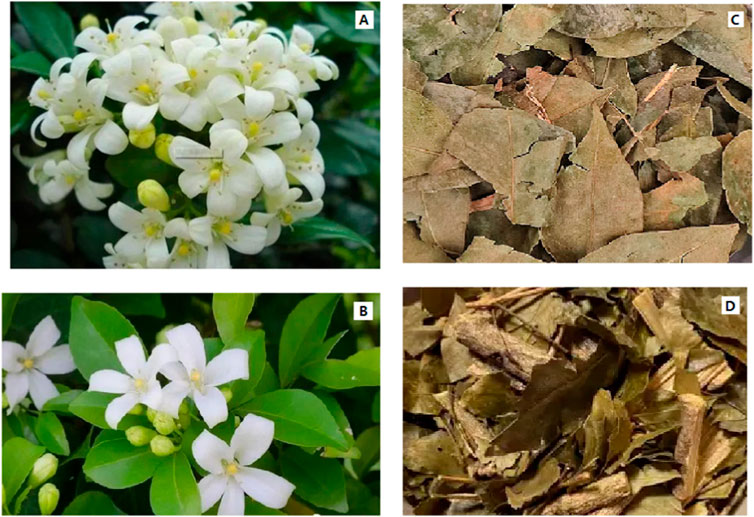
Figure 1. (A) M. paniculata; (B) M. exotica; (C, D) Murrayae Folium et Cacumen.
Murraya exotica are 2–8 m tall shrubs or trees. Older branchlets are grayish-white to pale yellowish-gray. The leaves are 3–7 foliolate, petiolules are rather short, leaflet blades are elliptic-obovate or obovate, and margins are entire, apex rounded, or obtuse (http://www.worldfloraonline.org) (Figure 1B).
2.2 Vernacular namesVernacular names—in other words, local, common, or non-Latin names for a plant or animal—are derived from common native languages and are distinct from binomial nomenclature. The name is derived from the plant’s morphology, habits, habitats, organoleptic properties, and therapeutic uses (Hossain et al., 2021). The vernacular names of MFC are listed in Table 1.
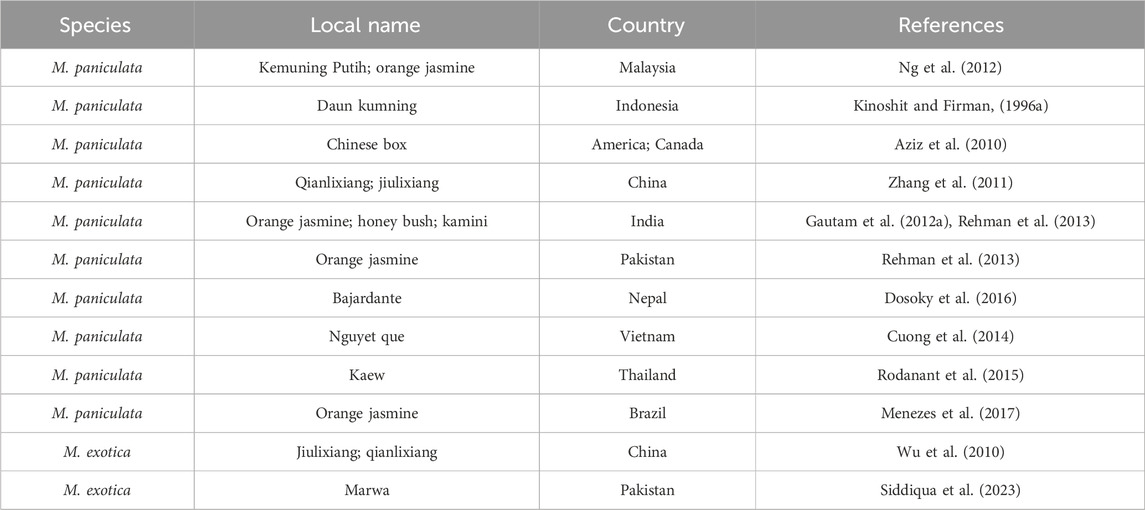
Table 1. Vernacular name of MFC.
3 Materials and methodsThis review focuses on the research advances in the phytochemical constituents, pharmacological activities, pharmacodynamics, pharmacokinetics, and toxicology of MFC. Related scientific literature up to August 2023 was collected from the following databases: PubMed, Elsevier, Web of Science, Springer, Science Direct, Wiley, ACS, and CNKI (Chinese). Doctoral and Master′s dissertations were also included in the analysis. We used the terms (all fields) “Murrayae Folium et Cacumen,” “Murraya paniculata,” “Murraya exotica,” and “Murraya” and collated all published works from the China Medical University Library. Only data published in English or Chinese were included in the analysis. ChemDraw 20.0 was used to extract the chemical compounds. The PubChem database (https://pubchem.ncbi.nlm.nih.gov) was used to confirm the chemical classifications and structures. World Flora Online (http://www.worldfloraonline.org/) was used to verify the names of the plants.
3.1 Inclusion and exclusion criteriaFirstly, duplicate articles, review articles, conference abstracts; non-English and non-Chinese articles were excluded. Further exclusions were duplicate articles and articles unrelated to the topic. Finally, 125 eligible articles were included.
4 PhytochemistryTo date, 316 compounds have been identified in MFC, including flavonoids, coumarins, alkaloids, sterols, phenylpropanoids, organic acids, spirocyclopentenones, and 404 volatile oils. These have been identified using thin layer chromatography (TLC), high-performance liquid chromatography (HPLC), ultra- performance liquid chromatography (UPLC), nuclear magnetic resonance (NMR), ultraviolet (UV), mass spectrometry (MS), NMR-MS, ultra-performance liquid chromatography-electrospray ionization-mass spectrometry (UPLC-ESI-MS), HR-FAB-MS, heteronuclear multiple-bond correlation (HMBC), heteronuclear multiple-quantum correlation (HMQC), and gas chromatography-mass spectrometry (GC-MS) (Kong Y. et al., 1985; Liu et al., 2015a; Kaur et al., 2016; Liang et al., 2020c; Saikia et al., 2021). Flavonoids are the main compounds of M. paniculata, whereas coumarins are the main compounds of M. exotica. Alkaloids mainly exist in the roots of plants but rarely in the twigs and leaves (Lu et al., 2021a). A detailed list of these chemical compounds and their classes is presented in Figures 2–5, and Tables 2–5 and Supplementary Table S.
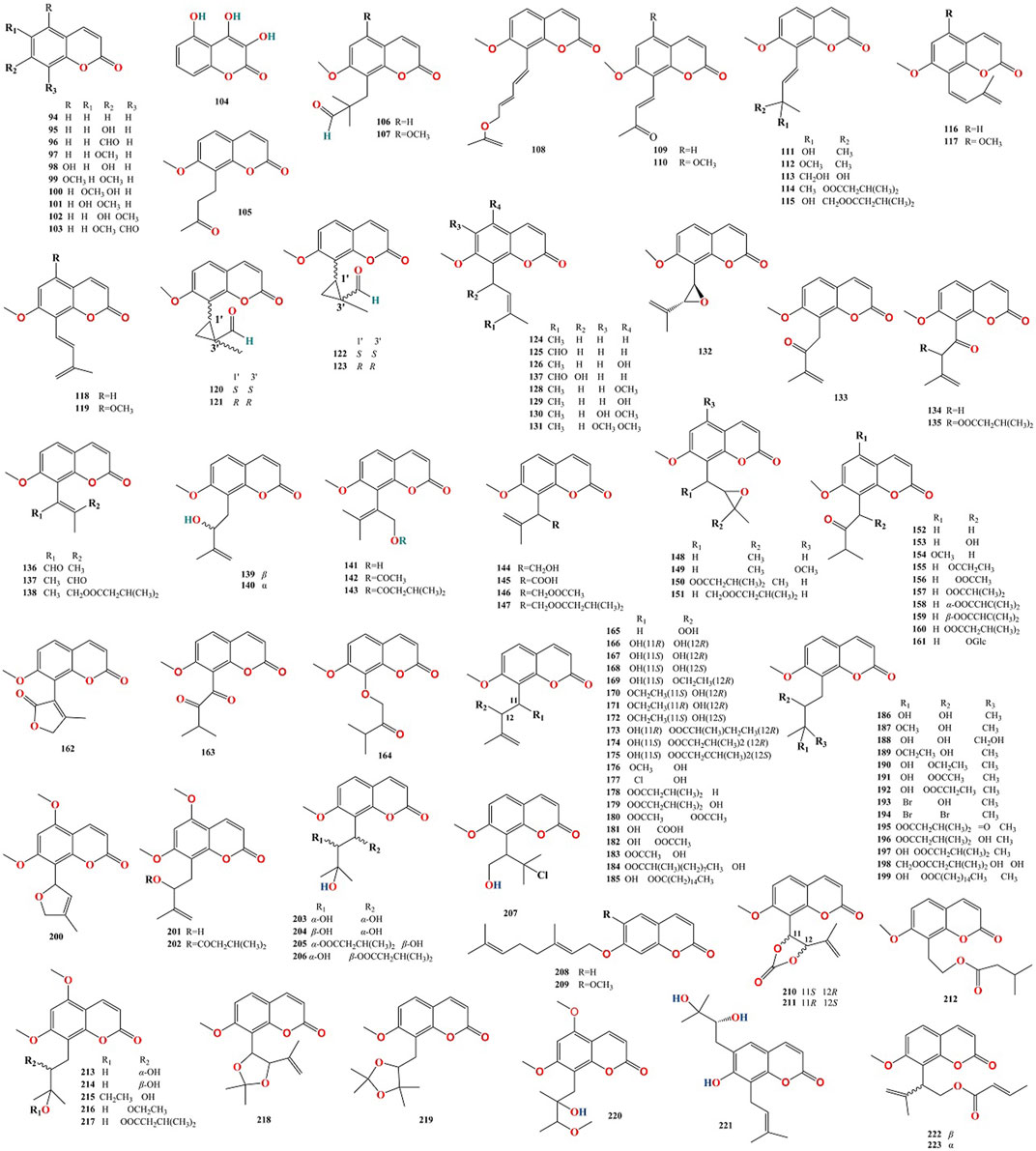
Figure 2. Chemical structures of flavonoids isolated from Murrayae Folium et Cacumen.

Figure 3. Chemical structures of coumarins isolated from Murrayae Folium et Cacumen.
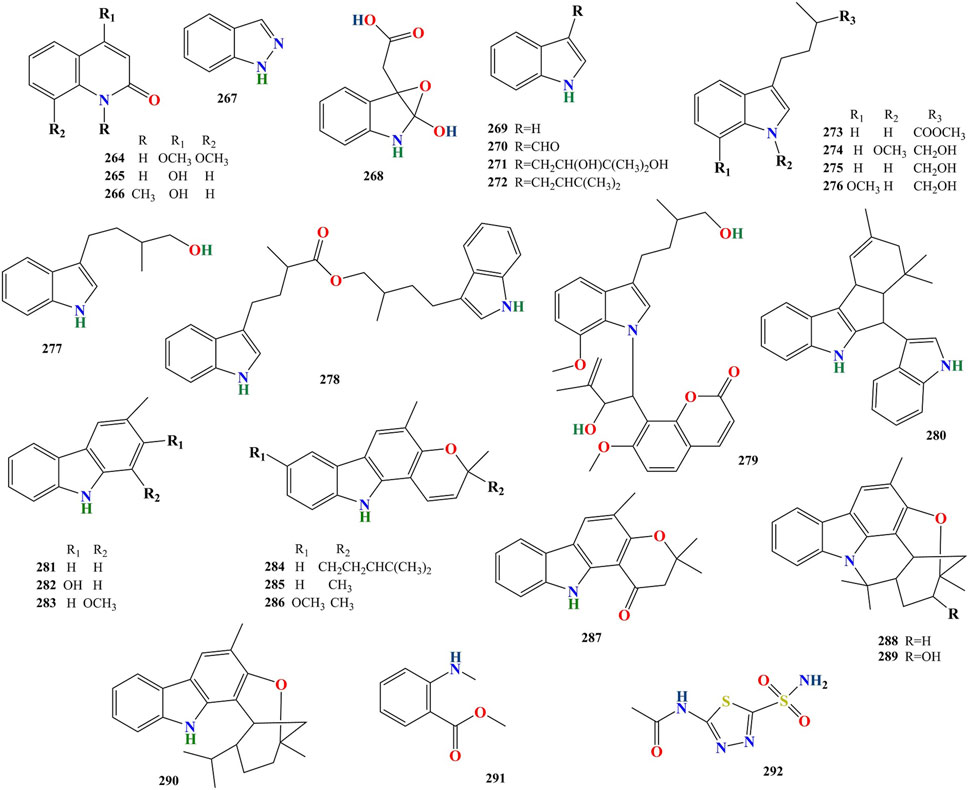
Figure 4. Chemical structures of alkaloids isolated from Murrayae Folium et Cacumen.
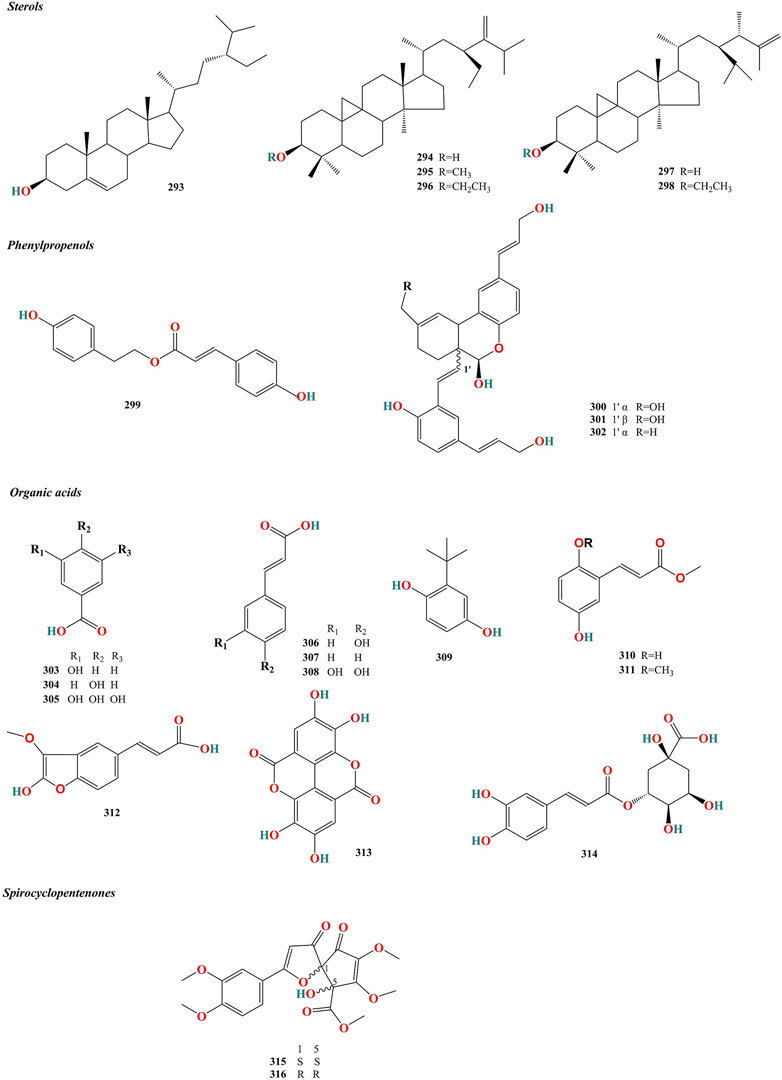
Figure 5. Chemical structures of sterols, pehylpropenols and other constituents isolated from Murrayae Folium et Cacumen.

Table 2. Flavonoids isolated from Murrayae Folium et Cacumen.

Table 3. Coumarins isolated from Murrayae Folium et Cacumen.

Table 4. Alkaloids isolated from Murrayae Folium et Cacumen.
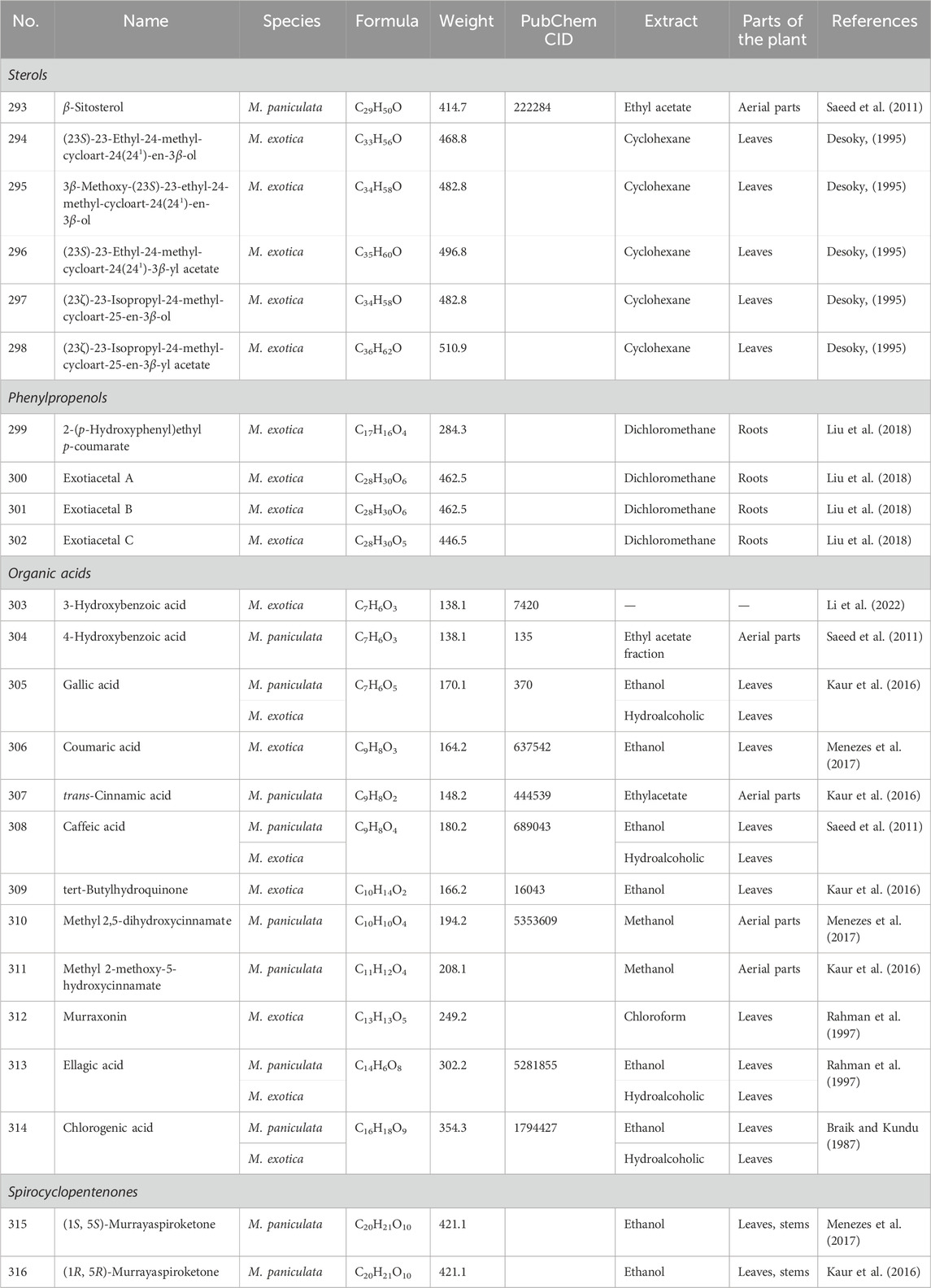
Table 5. Sterols, phenylpropenols, organic acids and spirocyclopentenones isolated from Murrayae Folium et Cacumen.
4.1 FlavonoidsNinety-three flavonoids (1–93, Table 2) have been identified in MFC. Of these, 72 compounds belong to the polymethoxylated flavonoid family, 90 were isolated from M. paniculata, and 24 were isolated from M. exotica, confirming that flavonoids were isolated mainly from M. paniculata (Lu et al., 2021a). Twenty-one compounds were isolated from M. paniculata and M. exotica (Negi et al., 2015; Sangkaew et al., 2020). Depending on their structure, flavonoids can be divided into six types: flavones, flavonols, flavanones, flavan-3-ols, chalcones, and isoflavones; of these, flavones are the primary structures of flavonoids in MFC (Figure 3).
4.2 CoumarinsOne hundred and seventy coumarins (94–263, Table 3) have been identified in MFC. Of these, 89 compounds were isolated from M. paniculata, 130 compounds were isolated from M. exotica, and 49 were isolated from both M. paniculata and M. exotica (Liu et al., 2018; Wang X. et al., 2019; Wang Y. et al., 2019). Depending on their structure, coumarins can be classified into six types: simple coumarins, prenylated coumarins, pyranocomarins, furanocoumarins, dimeric coumarins, and benzocoumarins (Figure 4).
4.3 AlkaloidsTwenty-nine alkaloids (264–292, Table 4) have been identified in MFC. Of these, 17 compounds were isolated from M. paniculata, and 12 compounds were isolated from M. exotica. No alkaloids have been isolated in both M. paniculata and M. exotica. Depending on their structure, alkaloids can be divided into six types: quinoline, indazole, indole, carbazole, organic amine, and other alkaloids (Figure 5).
4.4 SterolsSix sterols (293–298, Table 5) have been isolated from MFC (Desoky, 1995; Saeed et al., 2011) (Figure 5).
4.5 PhenylpropenolsFour phenylpropenols (299–302, Table 5) have been isolated from the roots of M. exotica (Liu et al., 2018), compounds 300 and 301 of which are isomers (Figure 5).
4.6 Organic acidsTwelve organic acids (303–314, Table 5) have been isolated from MFC (Rahman et al., 1997; Saeed et al., 2011; Kaur et al., 2016; Menezes et al., 2017) (Figure 5).
4.7 SpirocyclopentenonesTwo spirocyclopentenones (315 and 316, Table 5) have been isolated from M. paniculata (Liang et al., 2020a), including (1S, 5S)-murrayaspiroketone (315) and (1R, 5R)-murrayaspiroketone (316). Compounds 315 and 316 are enantiomers (Figure 5).
4.8 Volatile oilsFour-hundred and four volatile oils (317–711, Supplementary Table S) have been isolated from MFC (Pino et al., 2006; Raina et al., 2006; Krishnamoorthy et al., 2015; Silva et al., 2020; Saikia et al., 2021). The major volatile organic compounds dominated by benzenoids, sesquiterpenes, diterpenoids, triterpenoids, coumarins, and phenylethanoids in hydrodistillation and pentane, n-hexane, and dichloromethane extracts using GC-MS and gas chromatography-flame ionization detection (GC-FID). Of these, 287 compounds were isolated from M. paniculata, 244 compounds from M. exotica, and 127 from both M. paniculata and M. exotica. Sesquiterpenes are the predominant constituents of the essential oils from MFC. The main compounds are β-caryophyllene, spathulenol, α-zingiberene, α-copaene, germacrene D, and methyl palmitate (Lv et al., 2013; Dosoky et al., 2016; Silva et al., 2019).
5 Pharmacological activitiesModern pharmacological research has indicated that MFC has anti-inflammatory, anti-bacterial, anti-microbial, anti-diabetic, anti-tumor, and anti-oxidant properties (Lu et al., 2021a). The mechanisms of the compounds, extracts, and fractions from MFC are summarized in Table 6 and discussed in subsequent sections. Figure 6 summarizes the pharmacological mechanisms of MFC.

Table 6. Pharmacological Mechanism, models of compounds and various extracts in Murrayae Folium et Cacumen.
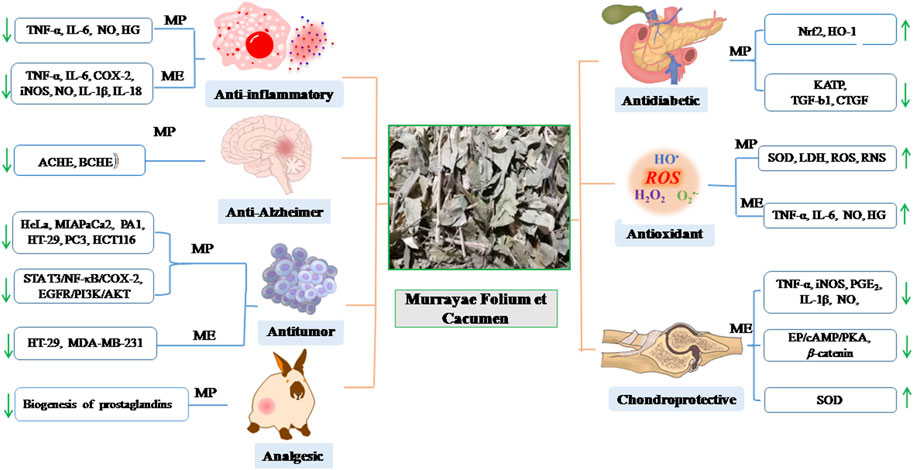
Figure 6. The pharmacological activity mechanism of Murrayae Folium et Cacumen (MP: Murraya. Paniculata; ME: M. exotica).
5.1 Anti-inflammatory activityGastric ulcers promote the release of inflammatory factors leading to acute and chronic gastric mucosal lesions (Wu et al., 2015). MFC is the main crude material of a patented Chinese drug compound “Sanjiu Weitai,” indicated for gastritis therapy (Lu et al., 2021a), indicating that MFC could exert anti-inflammatory effects.
A pharmacodynamical study demonstrated that the levels of interleukin (IL)-6, tumor necrosis factor-alpha (TNF-α), and prostaglandin E2 (PGE2) in the plasma of rats were significantly decreased at 300 and 600 mg/kg of M. paniculata and M. exotica, respectively, and there was no statistical difference in the inhibition of inflammatory cytokines between M. paniculata and M. exotica at the same dose, indicating a good anti-inflammatory effect (Lu et al., 2021a). Prenylated phenylpropenols and coumarin derivatives from MFC exhibit anti-inflammatory effects by inhibiting lipopolysaccharide (LPS)-induced nitric oxide (NO) production in BV-2 microglial cells (Liu et al., 2018; Wang X. et al., 2019). The total flavonoids of M. paniculata leaves efficiently exert anti-inflammatory effects by inhibiting high glucose-induced expression of TNF-α and IL-6 in H9c2 cells (Zou et al., 2021). Coumarin derivatives isolated from the extracts of M. exotica leaves and twigs show anti-inflammatory activity by inhibiting the release of NO via the nitric oxide synthase (iNOS) protein (Liang et al., 2020b). Wu et al. (2010) evaluated the anti-inflammatory activity models of ethanol extracts and coumarin compounds of M. exotica and reported that the mechanism of action may involve proinflammatory cytokines, such as IL-1β and TNF-α. Murracarpin (176) shows the most potential for anti-inflammatory activity.
Isosibiricin (154), a natural bioactive coumarin compound isolated from MFC, markedly inhibits the release of NO and production of TNF-α and IL-6 and reduces the expression of cyclooxygenase-2 (COX-2) and inducible iNOS in a concentration-dependent manner to exert anti-inflammatory effects (Kinoshita and Firman, 1996a; Wang Y. et al., 2019). Isomeranzin (7-methoxy-8-(3-methyl-2-oxobutyl) coumarin, 152) isolated from MFC produces the greatest inhibitory effect on proinflammatory factors, such as IL-1β and IL-6 mRNA expression and NO release. This suggests that compound 152 exerts anti-inflammatory effects primarily by selectively targeting macrophages via the inhibition of nuclear factor-kappa B (NF-κB) and extracellular signal-regulated kinase signals (Xu et al., 2016). The 2′-O-Ehylmurrangatin (169) isolated from M. paniculata leaves promotes moderate respiratory burst inhibition, which could have potential anti-inflammatory effects (Shaikh and Choudhary, 2011).
Murrangatin (166), murrangatin 2′-acetate (182), murranganonsenecionate (159), micropubescin (134), and 3′,4′,5′,7-tetramethoxyflavone (10) isolated from the leaves of the ethyl acetate extract of M. paniculata also show strong anti-inflammatory activity via LPS-stimulated macrophages to produce the inhibitory effect (Rodanant et al., 2015). Three flavonoids (8, 9, 25) isolated from the dried stems and leaves of M. paniculata mainly suppress LPS-activated production of NO and IL-6 with little cytotoxicity in a dose-dependent manner. Wu et al. (2015) suggested that the C-2, 3 double bond might have an important inhibitory effect on the production of NO and IL-6 by LPS-activated RAW 264.7 cells and mouse peritoneal macrophages.
5.2 Anti-bacterial and anti-microbial activitiesTo date, studies on anti-bacterial and anti-microbial activities have been focused on M. paniculata, not M. exotica.
Murrangatin (166), murrangatin 2′-acetate (182), murranganonsenecionate (159), micropubescin (134), and 3′,4′,5′,7-tetramethoxyflavone (10) isolated from the leaves of ethyl acetate extract of M. paniculata are active against Porphyromonas gingivalis. Compounds 166 and 182 show better anti-bacterial potency than the crude extract, indicating that coumarins are the main constituents responsible for the anti-bacterial effects (Rodanant et al., 2015). Different extracts of M. paniculata used against different strains of human pathogenic bacteria have exhibited a broad spectrum of anti-bacterial activities. The ethanol and hydroalcoholic extracts show mild-to-moderate activity against human pathogenic bacteria. The methanol extract of M. paniculata leaves shows obvious antibacterial activities against Gram-positive and Gram-negative bacteria. Anti-bacterial properties against human pathogens with high phenol and flavonoid content have been reported (Gautam et al., 2012a). One study reported that the ethanol extract of M. paniculata leaf showed broad-spectrum activity in inhibiting the growth of Staphylococcus aureus (half minimal inhibitory concentration [MIC50] = 406 μg/mL) (Panda et al., 2020).
Saikia et al. (2021) reported that volatile oils showed promising anti-bacterial activity against Mycobacterium smegmatis (MIC50 = 4 μg/mL) and Pseudomonas aeruginosa (MIC50 = 4 μg/mL). Twenty-nine compounds in the volatile oils of M. paniculata leaves were identified using GC-MS. Most of the volatile oils were sesquiterpene hydrocarbons (80%); the major compound was caryophyllene (20.93%). Silva et al. (2020) reported that volatile oils were also effective against Mycobacterium kansasii (MIC50 = 250 μg/mL) and moderately active against Mycobacterium tuberculosis, demonstrating anti-streptococcal and anti-mycobacterial activities (MIC50 = 500 μg/mL). GC-FID and GC-MS were used to analyze the volatile oils of M. paniculata leaves using hydrodistillation. Anti-fungal tests in vitro showed that essential oils had a 91.2% inhibitory effect on the growth of mycelia in Sclerotinia sclerotiorum. Eighteen compounds were identified using GC-MS in the volatile oils of M. paniculata leaves obtained using hydrodistillation. Rodríguez et al. (2012) reported that the volatile oils exerted moderate inhibitory effects against Klebsiella pneumoniae and Bacillus subtilis. GC-MS analysis of fresh leaf extract of M. paniculata by hydrodistillation identified 13 compounds using GC-MS analyses, including 99.3% sesquiterpenes and 0.3% monoterpenes. The major compounds were β-caryophyllene (320), α-zingiberene (325), and α-caryophyllene (336). Another study indicated that the volatile oils and β-caryophyllene (320) exhibited moderate anti-bacterial activity (MIC50 < 1.0 mg/mL) (Selestino Neta et al., 2017).
5.3 Anti-tumor (cytotoxic) activityPolymethoxyflavones (PMFs) exhibit a wide range of biological activities, including anti-inflammatory, anti-carcinogenic, and anti-tumor activities. Owing to the hydrophobicity of the methoxyl groups relative to the hydroxyl groups, PMFs are more lipophilic and inhibit tumor cell growth compared with hydroxylated flavonoids (Pan et al., 2007). The roots of M. paniculata and M. exotica are rich in coumarins, which exhibit cytotoxic activity in tumor cell lines (Shao et al., 2016; He et al., 2017). The leaves of M. paniculata also exhibits cytotoxic activity (Selestino Neta et al., 2017; Saikia et al., 2021).
The 5, 6, 7, 3′, 4′, 5′-hexamethoxyflavanone-8-O-[rhamnopyranosyl-(1→4)-rhamnopyranoside] (67) isolated from 75% ethanol extract of twigs of M. paniculata inhibited the adhesion, migration and invasion of lung adenocarcinoma A549 cells in vitro. Compound 67 blocked the adhesion of A549 cells to human pulmonary microvascular endothelial cells by targeting COX-2, matrix metalloproteinase (MMP)-2, and MMP-9 and blocked the NF-κB/signal transducer and activator of transcription 3 and epidermal growth factor receptor/phosphatidylinositol 3-kinase/protein kinase B signaling pathways, thereby blocking the invasion and migration of targeted cancer cells and downregulating their epithelial–mesenchymal transition phenotype. Compound 67 inhibited the adhesion of cancer cells to abnormal endothelial cells by regulating the cellular microenvironment (Shi et al., 2017).
The raw methanol/dichloromethane extracted fraction (containing flavonoids and coumarins) of M. paniculata had a high adhesion inhibition rate, and the inhibition effect on human endothelial cells HT29 was concentration-dependent (1–30 μg/mL). In addition, this fraction inhibited the invasion and migration of HT29 cells. Oral administration of the fraction substantially inhibited lung metastasis in immunized mice inoculated with murine melanoma cells, without obvious side effects (Jiang et al., 2016).
Phebalosin (132) and murralongin (136), isolated from 80% acidic ethanol extracts of M. paniculata roots, inhibited the adhesion of cancer cells to the vascular intima because they specifically targeted cell–cell adhesion at low concentrations (Shao et al., 2016). Pharmacodynamic experiments showed that coumarin extracts from M. exotica roots had low cytotoxicity and high resistance to HT-29 tumor cells and could substantially inhibit the migration of tumor cells (Jiang et al., 2015). The root extracts of M. exotica were more efficient in restraining cell migration and had a slightly lower inhibition of cell adhesion in MDA-MB-231 cells than the leaf extracts in vitro. Compounds isolated from the roots of M. exotica show obvious inhibitory effects on the adhesion and migration of tumor cells (He et al., 2017).
The volatile oils from fresh leaves of M. paniculata exhibited a half maximal inhibitory concentration (IC50) value of 63.73 μg/mL for tumorous cells of hepatocytes in a study by Selestino Neta et al. (2017). Twenty-nine compounds in the essential oil of M. paniculata leaf were identified using GC-MS. The major compound was caryophyllene (20.93%), which had an obvious inhibitory effect on HeLa, MIAPaCa2, and PA1 cell lines (Saikia et al., 2021).
5.4 Anti-diabetic activityThe total flavonoids extracted from M. paniculata (TFMP) effectively alleviated kidney damage in diabetic rats. The effects of TFMP on diabetic nephropathy may involve the regulation of glucose, lipid metabolism, oxidative stress, and inflammatory cytokines (Zou et al., 2014). Zou et al. (2021) found that TFMP could decrease the occurrence of diabetic cardiomyopathy in type 2 diabetic rats, and the protective effect may upregulate the expression of the NF-E2-related factor 2 and heme oxygenase-1 genes, inhibiting oxidative stress, inflammation, and apoptosis (Zou et al., 2021). The extract of M. paniculata leaves decreases glucose levels in alloxan-induced diabetic rats, effectively treating diabetes-related complications, such as hypercholesterolemia and hypertriglyceridemia, and reducing the damage associated with diabetic status. The hypoglycemic effect is similar to that of glibenclamide and metformin, which are related to the inhibition of ATP-sensitive potassium channels (Menezes et al., 2017).
The flavones extracted from M. paniculata leaf mainly include 5, 6, 7, 3′, 4′, 5′-hexamethyl flavone (3), 5, 6, 7, 3′, 4′-pentamethoxyl flavone (6), 5, 7, 3′, 4′, 5′-pentamethoxyl flavone (8), 5, 7, 3′, 4′-tetramethoxy flavone (9), and 7-hydroxyl-5, 3′, 4′-trimethyl flavone (32). A patent disclosed that the flavonoids could remarkably reduce blood glucose; improve the disturbance of lipid metabolism; increase the C-peptide level and the content of insulin in the serum; improve the excretion index of β cells of insulin and insulin resistance; reduce the insulin resistance index, malondialdehyde content in the blood serum, and contents of IL-1β, IL-6, and TNF-α; and improve superoxidase dismutase (SOD) activity (Jin et al., 2008).
5.5 Anti-oxidant activityVarious in vitro studies have shown that 50% ethanol extract of M. paniculata leaves possessed strong anti-oxidant activity (Gautam et al., 2012b). GC-MS was used to identify 18 compounds in volatile oils of M. paniculata leaves obtained via hydrodistillation. These volatile oils showed strong anti-oxidant activity, and the main component is β-caryophyllene (320) (Rodríguez et al., 2012).
Research has shown that ethyl acetate fraction of M. exotica leaves, which is rich in polyphenols and flavonoids, exhibits the highest anti-oxidant activity of the different parts obtained using the sequential extraction method (Kaur et al., 2016). The methanol extract of M. exotica leaves has been reported to contain numerous flavonoids and polyphenols, and these compounds show marked anti-oxidant activity (Khatun et al., 2014).
5.6 Chondroprotective activityWu and coworkers (2010) found the 70% ethanol extract of M. exotica leaves significantly reduced iNOS activity and IL-1β and TNF-α contents, increaseed SOD activity, decreaseed NO production, protected cartilage and chondrocytes from destruction, and maintained the normal function of femoral condyle cartilage and the arrangement of different layers of chondrocytes. Another study demonstrated that 70% ethanol extracts of M. exotica decreased the contents of TNF-α and IL-1β in rat osteoarthritis synovial fluid by inhibiting the β-catenin signaling pathway, and reduced chondrocyte apoptosis in vitro (Wu et al., 2013). 5,7,3ʹ,4ʹ-Tetramethoxyflavone (9) has been demonstrated to improve chondrocyte apoptosis by inhibiting Wnt/β-catenin signaling in vivo and in vitro (Wu et al., 2014). Further studies show that compound 9 from M. exotica exhibits chondroprotective activity by upregulating Foxo3a expression and inhibiting miR-29a/Wnt/β-catenin signaling activity (Huang et al., 2019).
5.7 Potential anti-Alzheimer’s disease activityAlzheimer’s disease (AD) is a neurodegenerative disease that causes progressive loss of neuronal structure and function, leading to cognitive decline and dementia (Kabir et al., 2021). Some natural products have promising anti-AD properties. Acetylcholinesterase/butyrylcholinesterase (AChE/BChE) inhibitors are desirable because they improve cognition with minimal side effects (Wojtunik-Kulesza et al., 2021). In one study, the essential oil of M. paniculata leaves was the most potent selective BChE inhibitor with an IC50 of 5.1 ± 0.3 μg/mL and showed strong inhibitory activity against AChE (IC50 = 13.2 ± 0.9 μg/mL). Germacrene D (324), α-zingiberene (325), and δ-elemene (333) had a high affinity for BChE. These volatiles, with their in vitro cholinesterase inhibitory potential, have demonstrated a novel and safe treatment for AD (El-Shiekh et al., 2023). Experimentally, paniculatin (160) is most potent against AChE (IC50 = 31.6 µM), whileas murranganone (153) is the most potent against BChE (IC50 = 74.3 µM); neither compound shows selectivity toward any of the two enzymes. Paniculatin (160) is a mixed-type inhibitor of both AChE and BChE, whereas murranganone (153) promotes pure noncompetitive inhibition of AChE and BChE. Compound 2′-O-ethylmurrangatin (169) has no inhibitory effect on AChE but has a very weak inhibitory effect on BChE. These three coumarins represent a new class of natural coumarins that are active against cholinesterases. Therefore, they can be considered potential candidates for AD treatment. These coumarins show non-selective, moderate-to-good in vitro activity against both AChE and BChE via a mixed-type inhibitory mechanism (Khalid et al., 2023).
5.8 Analgesic activityThe bark extract of M. paniculata (200 and 400 mg/kg) has an obvious inhibitory effect on the writhing bodies of mice, and the degree of the inhibitory effect increases with increasing dose. The results at both doses are comparable to those of the standard drug aminopyrine. A similar analgesic activity was observed using the radiant heat method (Podder et al., 2011).
5.9 Other activitiesYuehchukene (280) from M. paniculata has been shown to exhibit long-standing anti-implantation and estrogenic activity (Kong YC. et al., 1985).
M. paniculata is widely used to treat mental health disorders. The chloroform (200 mg/kg) and ethanol (400 mg/kg) extracts of M. paniculata leaves demonstrate marked anxiolytic and anti-depressant activities, respectively (Sharma et al., 2017). The chloroform extract of M. paniculata leaves showed a moderate level of anti-giardial and anti-amoebic activity in vitro in patients with AIDS in southern Thailand (Sawangjaroen et al., 2005; Sawangjaroen et al., 2006).
Cuong et al. (2014) reported that the chloroform fraction of the methanol extract of M. paniculata leaves had the most potent vasorelaxing effect on rat aortic rings contracted using 60 mM K+. Kimcuongin (225) and murracarpin (176) isolated from the chloroform fraction showed vasorelaxant activity with IC50 values of 37.7 µM and 139.3 µM, respectively, suggesting that M. paniculata has an anti-hypertensive effect (Cuong et al., 2014).
6 Pharmacodynamics and pharmacokinetics6.1 PharmacodynamicsOne pharmacodynamic study of MFC indicated that both M. exotica and M. paniculata markedly inhibited the writhing reaction induced by acetic acid in mice and the paw swelling induced by carrageenan in rats; decreased IL-6, TNF-α, and PGE2 levels in the plasma of rats with swollen paws; and increased the gastric emptying rate and intestinal propulsive rate in a dose-dependent manner. M. exotica and M. paniculata did not indicate marked differences at the same dose and are therefore considered to have similar anti-inflammatory, analgesic, and gastrointestinal motion-promoting effects (Lu et al., 2021a). The authors compared the preventive effects of M. exotica and M. paniculata against alcohol-induced gastric lesions. MFC effectively attenuated ethanol-HCl-induced gastric diseases by reversing inflammatory development and preventing ethanol-HCl-induced necrosis and apoptosis (Lu et al., 2021b).
6.2 PharmacokineticsA novel, fast, and sensitive UPLC–tandem mass spectrometry method with a sample preparation procedure, low limit of quantitation, short run time, and good accuracy was used to easily detect murrayone (133) extracted from M. paniculata in rat plasma. This method has been successfully applied in pharmacokinetic studies. Zhai et al. (2020) studied Sprague-Dawley rats administered with 20, 50, or 125 mg/kg murrayone intra-gastrically or 20 mg/kg murrayone via intravenous bolus injection. The mean Tmax values of the relevant pharmacokinetic parameters ranged from 0.75 h to 1 h for all doses, indicating rapid murrayone absorption. The mean T1/2 was 3.52–5.97 h for all dose groups, indicating that the rate of murrayone elimination was also rapid. The relatively high Vd/F indicated that murrayone was widely distributed in the body and combined with tissues. The absorption rate of murrayone was high, and the absolute bioavailability of murrayone was 22.72%–37.81% in rats. The exposure level of murrayone was positively correlated with the dose administered, indicating that the in vivo pharmacokinetic behavior of murrayone is linear (Zhai et al., 2020).
7 ToxicologyThe constituents and extracts of MFC have been studied for their pharmacological activity. However, studies on the potential toxicology of these compounds are limited.
In male and female Swiss mice, acute toxicity was assessed using a single oral dose of the hydroethanolic extract of M. paniculata leaves (2,000 and 5,000 mg/kg bw/day). No abnormal signs of toxicity (e.g., piloerection, diarrhea, or alteration in locomotor activity) or death were observed during the 14 days of observation (Menezes et al., 2015). The aqueous extracts of M. paniculata leaves against Artemia salina were presented as total phenolic compounds. The percentage mortality of brine shrimp increased with the concentration of the aqueous extract of M. paniculata, which has been shown to have a significant effect on brine shrimp (Bovornvattanangkul and Jiraungkoorskul, 2016). Liaqat et al. (2018) studied Wistar rats with free access to food and water that were administered with 400 mg/kg volatile oils of M. paniculata. The MIC and MBC results showed that the oils of M. paniculata were active against Gram-positive strains. Moreover, elevation in packed cell volume and depletion in mean corpuscular volume were observed; therefore, the volatile oils of M. paniculata are considered safe for internal use (Liaqat et al., 2018). The half lethal concentration (LC50) and 90% lethal concentration (LC90) values of petroleum ether extract and crude methanol extract from M. paniculata leaves were 0.471 ± 0.72 μg/mL and 0.773 ± 0.19 μg/mL, respectively, showing high cytotoxic activity in a brine shrimp lethal test (Mita et al., 2013). Another study showed that the ethanol extract (250 and 500 mg/kg dosages) of M. paniculata leaves produced strong anti-nociceptive activity and was toxic to brine shrimp (half lethal dose [LD50] = 32 μg/mL) (Sharker et al., 2009).
Khatun et al. (2014) identified the methanol extract from M. exotica leaves using a brine shrimp lethality assay. After 24 h, the LC50 and LC90 values of the extract were 1.27 μg/mLand 5.09 μg/mL, respectively, indicating cytotoxic effects (p < 0.01). The volatile oils of M. exotica possessed fumigant toxicity against Sitophilus zeamais and Tribolium castaneum adults, with LC50 values of 8.29 and 6.84 mg/L, respectively. The essential oils also showed contact toxicity against S. zeamais and T. castaneum adults with LD50 values of 11.41 and 20.94 μg/adult, respectively (Li et al., 2010).
8 Conclusion and future perspectivesMFC contains at least 720 components, 404 of which are volatile oils. Crude extracts and their chemical compounds have been shown to exert anti-inflammatory, anti-bacterial and anti-microbial, antitumor, anti-oxidant, anti-diabetic, anti-Alzheimer, and analgesic effects. Flavonoids, coumarins, and volatile oils are the most important bioactive compounds with pharmacological activity.
The compounds of M. paniculata and M. exotica differ in that flavonoids are the main compounds in M. paniculata, whereas coumarins are the main compounds in M. exotica. Flavonoid compounds, particularly polymethoxyflavones, exhibit anti-inflammatory, anti-bacterial, anti-microbial, antitumor, and chondroprotective effects. Coumarin compounds, especially prenylated coumarins, exhibit anti-inflammatory, anti-bacterial, anti-microbial, antitumor, potential anti-Alzheimer, chondroprotective, anti-implantation, estrogenic, and anti-hypertensive properties. Studies on volatile oil compounds have primarily focused on their anti-bacterial, anti-microbial and potential anti-Alzheimer effects.
Despite the remarkable outcomes of previous studies on MFC (M. paniculata and M. exotica), some questions remain, and further research is needed to bridge the current scientific gap. First, although MFC demonstrates considerable pharmacological activity, little is known about the active parts and components, and further research and exploration are warranted. Second, we focused more on the analysis of polymethoxyflavones and coumarins and less on the quality control of MFC. A quality control assessment of MFC is needed to ensure quality. Third, there are many studies on the pharmacological activities of M. paniculata and M. exotica; however, only two comparative studies on the pharmacodynamics have shown no statistical differences between M. paniculata and M. exotica.
Meanwhile, in pharmacological studies, most of the studies are limited to in vitro cell studies, while in vivo studies are rarely involved. So far, only two studies are related to clinical indications, which limits the further clinical use of MFC. In view of these gaps and challenges, we should focus on in vivo pharmacological research, the relationship between efficacy and mechanism of action, and activity research on the structure-activity relationship of compounds in the future. Fourth, the antitumor activity of MFC has been described as cytotoxic, but no in vivo model is currently available and further in vivo model and clinical tumor patient studies are needed. Fifth, there are no systematic reports on the mechanisms of MFC. MFC is mainly used in the treatment of stomach pain, rheumatism, arthralgia, toothache, and tumefaction; however, the underlying mechanisms remain unclear, except for the protective effects on gastric lesions. Volatile oils are the most abundant and promote important insecticidal activity; however, their composition varies markedly depending on their origin. Therefore, there is an urgent need to establish quality standards for MFC.
At present, the phenomenon of “heterogeneous equivalence” is widespread in many multisource traditional Chinese medicines. Therefore, several problems are associated with its clinical application, such as efficacy equivalence and quality control (Lu et al., 2021b). To ensure its efficacy and safety, it is necessary to study the rationality of two source plants, M. paniculata and M. exotica, used as the same kind of MFC. Therefore, we conducted a comprehensive review of the phytochemistry, pharmacology, pharmacodynamics, pharmacokinetics, and toxicity of M. paniculata and M. exotica. This systematic review of MFC provides a material and theoretical basis for rational and effective utilization and also provides direction for in-depth research.
In conclusion, although there have been many studies on the phytochemical and pharmacological effects of MFC, there are still many aspects that require further research and control to lay a theoretical foundation for their heterogeneous use.
Author contributionsYQ: Writing–review and editing. LW: Writing–review and editing. NW: Writing–review and editing. SW: Writing–review and editing. XZ: Writing–review and editing. TZ: Writing–review and editing. QJ: Funding acquisition, Writing–review and editing.
FundingThe author(s) declare financial support was received for the research, authorship, and/or publication of this article. This current work was supported by Natural Science Foundation of Liaoning Province (No. 2015020746) and 345 Talent Project of Shengjing Hospital of China Medical University.
Conflict of interestThe authors declare that the research was conducted in the absence of any commercial or financial relationships that could be construed as a potential conflict of interest.
Publisher’s noteAll claims expressed in this article are solely those of the authors and do not necessarily represent those of their affiliated organizations, or those of the publisher, the editors and the reviewers. Any product that may be evaluated in this article, or claim that may be made by its manufacturer, is not guaranteed or endorsed by the publisher.
Supplementary materialThe Supplementary Material for this article can be found online at: https://www.frontiersin.org/articles/10.3389/fphar.2024.1337161/full#supplementary-material
AbbreviationsAChE, acetylcholinesterase; AD, Alzheimer’s disease; BChE, butyrylcholinesterase; COX-2, cyclooxygenase-2; GC-FID, gas chromatography-flameionization detection; Foxo3a, Forkhead box class O 3a; GC-MS, gas chromatography-mass spectrometry; IC50, half maximal inhibitory concentration; IL, interleukin; iNOS, nitric oxide synthase; LC50, lethal concentration 50; LPS, lipopolysaccharide; MFC, Murrayae Folium et Cacumen; MIC, minimum inhibitory concentration; MIC50, half minimal inhibitory concentration; MMP, matrix metalloproteinase; NF-κB, nuclear factor-kappa B; NO, nitric oxide; PGE2, and prostaglandin E2; PMFs, polymethoxyflavones; TFMP, total flavonoids extracted from Murraya paniculata; TNF-α, tumor necrosis factor alpha; SOD, superoxidase dismutase.
ReferencesAlam, F., Mohammadin, K., Shafique, Z., Amjad, S. T., and Asad, M. H. H. b. (2021). Citrus flavonoids as potential therapeutic agents: a review. Phytother. Res. 36, 1417–1441. doi:10.1002/ptr.7261
留言 (0)